
South Africa has been a hotspot of fossil discovery since the first human ancestor fossil was found in the Taung (formerly Buxton-Norlim) Limeworks in 1924. The original discovery of the now famous Taung Child began a fossil journey that found its peak in a small area just north of Johannesburg, South Africa, now known as the Cradle of Humankind and recognized as a UNESCO World Heritage Site. One of the first fossils discovered in the Cradle area, in 1938, was a partial skull (first found by a young boy, Gert Terblanche, who lived on the Kromdraai Farm) that Dr Robert Broom assigned to the species Paranthropus robustus.
Some 50 years later, another important Paranthropus site was discovered by Dr Andre Keyser, a South African palaeontologist and geologist — the Drimolen Fossil Site. The site is located almost directly in the middle of the demarcated Cradle boundaries and very quickly proved to be a site of high significance. After two years of excavation, Keyser discovered a pair of crania, designated DNH 7 and DNH 8 (or more romantically, Euridice and Orpheus, respectively). DNH 7 is the most complete cranium of the species thus far discovered and DNH 8 is a well preserved large male mandible with teeth. DNH 7 has become particularly significant since it was discovered that she was, in fact, a she. This was important because up until her discovery in 1994 and subsequent description in 2000, no other well-preserved crania of female Paranthropus had been discovered. Her diminutive, sagittal crest–lacking head gave scientists much needed insight into the sexual dimorphism of Paranthropus robustus and led to changing our understanding of the species’ lifestyles.
Since the initial description of DNH 7, multiple specimens of both Paranthropus and early Homo have been discovered here, making Drimolen one of the richest hominin-bearing deposits in South Africa. The site is geologically quite simple, unlike some of our neighboring sites, which feature multiple infills and members. The Drimolen deposit is made up of only one simple phreatic maze cave chamber, now exposed through years of surface erosion and later lime miner activity. The fossil deposits are clustered mainly along the western edge of the cave walls, where large breccia blocks and pinnacles still stand today, preserving clues of the original infill shape and cave entrance. Mining activity created what is now called the Central Excavation Area (CEA), where one large breccia block, formerly from the cave ceiling, is surrounded by decalcified sediments that are essentially ex situ. These deposits were the focus of the bulk of all previous excavations, directed by both Keyser and, later, Colin Menter.
_________________________________
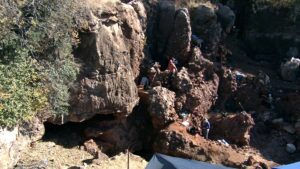
The Drimolen Main Quarry site under excavation. Therese van Wyk, University of Johannesburg.
_________________________________

The Drimolen excavations and excavated fossils. Andy Herries
_________________________________
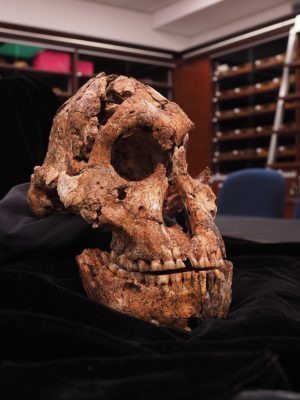
The DNH 7 Paranthropus robustus skull discovered at Drimolen is the most complete skull of this species ever discovered. Andy Herries, Creative Commons Attribution-Share Alike 4.0 International license, Wikimedia Commons
_________________________________
DNH 134 and the Implications
I first joined the project in 2011 as a student assistant and assumed the permit fully in 2017, alongside my co-permit holder, Prof Andy Herries. With this changeover in permit holders came a changeover in approach to the excavations. The primary area of focus moved to the western edges of the cave wall, both in the CEA and over the back of the pinnacle row. This change heralded a flurry of new discoveries of extremely well-preserved hominin fossils, including the recently published DNH 152 Paranthropus robustus male specimen.
That publication included a second specimen of great importance — DNH 134. This find is now described as the oldest Homo erectus specimen in the world (at 1.95 to 2.04 million years old), as well as the first recorded representative of the species in South Africa. DNH 134 has a fascinating discovery story and illustrates the complexity of the excavations, the difficulty of working with such highly fragmentary fossils, as well as the importance of including young researchers and students in major analysis. In June of 2015, the University of Johannesburg and La Trobe University palaeo-anthropological field season was underway. Students (both under- and postgraduate) had travelled to South Africa for the opportunity of field training and excavation experience at Drimolen. One of these students, Richard Curtis, was excavating a small area in the south west corner of the CEA when he began uncovering a cluster of skull fragments. The fragments were not immediately identifiable beyond saying they came from a skull. With this, I began the in-field reconstruction of this ancient puzzle.
It took a good number of days working alongside Richard to recover more fragments before some semblance of a shape took place. Eventually, I had two larger pieces with which to work. One was clearly the base of the cranium: the occipital and part of the foramen magnum. The other was the top of the skull. At first, there was no obvious link between these fragments — until one day, after Richard had collected a number of cranial pieces in a chunk of sediment. I sat that evening at the far end of the field school site dinner table, fully engrossed in my puzzle and completely ignoring the lecture happening at the other end of the room. One of the remarkably uninteresting and amorphous blob fragments recovered from the ground that same day turned out to be the bridge that linked the two larger fragments I had reconstructed. In that wonderful eureka moment, as the two pieces came together, I gasped — apparently far louder than I had intended, as the aforementioned lecture came to a very swift halt.
It was immediately clear that the small skull was that of a hominin, not of a baboon, as had previously been suggested along with buck, hyaena, and others. The next step was to figure out: what kind of hominin? Thereafter, the skull was entrusted to Jesse Martin, now a PhD candidate at La Trobe University in Melbourne Australia. After much comparison work in the Phillip V Tobias Fossil Hominid vault at the University of the Witwatersrand, Jesse made a difficult phone call to the rest of us. He found that the DNH 134 cranium was actually Homo erectus. We laughed, at first. Homo erectus had never been found in South Africa before and the likelihood that we would find it at Drimolen was low. At the time, we also didn’t have the absolute dates for the site, so we believed the deposit to be around 1.8 million years old, and some estimates had it even younger at around 1.5 million. By this time in the fossil record, Homo ergaster (the African cousin to erectus) was quite solidly established in East African, with beautiful specimens such as Nariokotome Boy (KNM-WT 15000; c. 1.6-1.5 Ma from Lake Turkana, Kenya), among others.
But after he fought his case, we were convinced! The overall cranial shape was convincingly Homo erectus. When viewed from above, it has the characteristic teardrop shape seen in all Homo erectus specimens. This shape is indicative of the beginnings of the larger, reorganized brain we see in modern examples of the genus Homo, to which modern humans belong, along with other Homo species. The brain size (~538 cc) is on the high end compared to both Australopithecus and Paranthropus, despite this specimen representing an individual juvenile. The brain size is smaller than the Mojokerto child from Indonesia (~630cc), a specimen of similar developmental age but much younger geologically (~1.8-1.2 Ma). This suggests that while the brain shape is forming early in the evolution of Homo erectus morphology, the size increase develops later.
Homo erectus is well-represented in the fossil record but also well-sampled from across many continents. They were highly adaptive and capable of transitioning across numerous diverse landscapes in very short – geologically speaking – periods of time. Discovering Homo erectus in southern Africa is another indicator that, firstly, we need to constantly be rethinking our understanding of human evolution, and secondly, it reconfirms this species’ incredible adaptive abilities. The next oldest location where Homo erectus was discovered—the famous Dmanisi site in the Republic of Georgia—was dated to approximately 1.8 Ma. These specimens, mostly adults, are a good 11 thousand kilometers away from Drimolen. It suggests that this species’ journey out of Africa took place in less that 200 thousand years, considered an unprecedented trip for early Pleistocene apes. This implies a high level of survivability, adaptability and certainly a good dose of curiosity.
__________________________
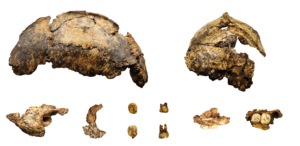
The Paranthropus robustus skull DNH 152 found at the Drimolen Main Quarry in 2018. Andypithecus, Attribution-Share Alike 4.0 International license. Wikimedia Commons
__________________________
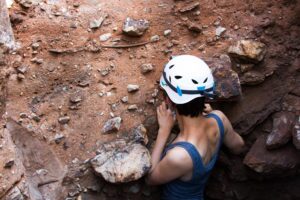
La Trobe University PhD student Angeline Leece in front of fossil bearing brecccia at Drimolen. Jesse Martin
__________________________

Detailed side view of the DNH-134 Drimolen Homo erectus cranium. Dr. Matthew Caruana
__________________________
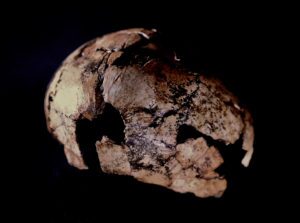
View of the DNH-134 cranium skull cap from above. Therese van Wyk, University of Johannesburg.
__________________________
Our Next Steps
Moving forward, the Drimolen team hopes to add to the sample. DNH 134 is a small child of around 1-3 years old, so recovering an adult specimen would be excellent. Adding to the Homo erectus finds at the site will aid to understanding the species and its evolution in southern Africa. We also need to go back through the hominin collection amassed thus far from the site and reassess some of those specimens previously assigned simply to ‘early Homo’. Even more important, the team hopes to work through a lot of the other fauna excavated from the site since its’ discovery in 1992. Each excavated fossil adds to our understanding of how Homo erectus, Paranthropus robustus and late-occurring Australopithecus all navigated this transitional landscape. We know that the environment was shifting over this time, so it marks a critical moment in our evolutionary history, potentially impacting the next step in the journey to becoming human.
________________________________

Stephanie Baker with DNH 134. Dr. Matthew Caruana
________________________________




